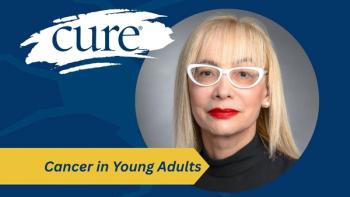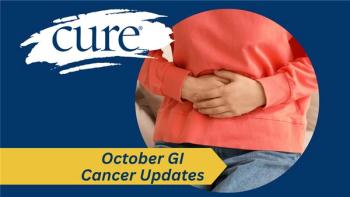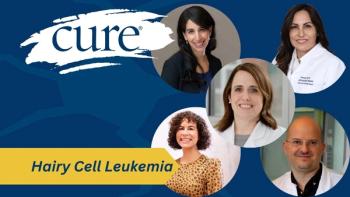
Patients With Cancer and Their Providers Share Stories of Hope
Patients and providers shared inspiring stories of hope, as well as some tips for better living at the Seventh Annual Ruesch Center Symposium: Fighting a Smarter War on Cancer.
Two years ago, Emily Pomeranz went into hospice care, nearing the end of her life, after her cancer had spread to her pancreas, liver and two spots on her lung. It was her third battle with the disease, and also her worst.
But in a turn of events, instead of losing her battle she recovered, came off of hospice and is alive to share her inspirational story today. She did just that at a live broadcast of CURE Connections held during the Seventh Annual Ruesch Center Symposium: Fighting a Smarter War on Cancer on Dec. 3 in Washington, D.C.
She told an audience of patients, survivors, caregivers and physicians how she fought and won her battle against Hodgkin’s lymphoma when she was 20 years old thanks to aggressive radiation treatments — only to discover 20 years later that she had cancer again, this time in her breast.
Pomeranz told how she read an article in The Washington Post about radiation in the 80’s and women being diagnosed with breast cancer years later. This prompted her to go for an MRI which led to a stage 1 breast cancer diagnosis.
“Radiation was like a weird double-edged sword,” she told the crowd. “I had viewed it as my saving grace because it cured me of the Hodgkin’s disease initially, so it never crossed my mind that it could actually cause harm to me.” She underwent a mastectomy, but seven years later, at age 47, she was diagnosed with stage 4 pancreatic cancer. After only five rounds of treatment, she stopped and entered hospice.
“If it had been the first time I had been diagnosed with cancer, I would have been more of a fighter, but frankly, in my case, it made me less of a fighter. I felt beaten down,” said Pomeranz.
When her cancer wasn’t getting progressively worse, she left hospice. That was January 2015, and a few months later, in April, her scans showed that all of her tumors were gone.
Philippa Cheetham, M.D., host of CURE Connections called her a “living, breathing miracle.”
The day-long patient symposium featured live panel discussions on specific cancers including colorectal, pancreatic and liver and biliary, as well as nutrition, the unmet needs of patients with gastrointestinal cancer and support that is available.
“It affects young people and old people, men and women and we need to speak with one voice” said John Marshall, M.D., director of the Ruesch Center for the Cure of Gastrointestinal Cancers, Georgetown Lombardi Comprehensive Cancer Center. “Part of our mission here at the Ruesch Center is to convene and to bring people together, to speak with that one voice.” As the live panel went on, more and more patients took to the stage sharing their courageous stories, many sitting alongside the doctors who treated them.
It was Labor Day weekend and Phillip Hay was moving his daughter into her first apartment when he noticed a pain on his left side. After getting a scan done in the emergency room, he was told there were “spots” on his liver and pancreas. The ER doctor told him to follow-up with an oncologist, which he did. A biopsy confirmed that he had pancreatic cancer. He didn’t understand it. He was healthy, active and had even begun preparing for a climb of Mount Kilimanjaro just prior to his diagnosis.
“I was concerned that I am a father to three daughters, I am married to my wife for 25 years and I enjoyed my job, so I was prepared to do whatever it took,” said Hay.
He has undergone treatment and experienced minimal side effects, which Michael Pishvaian, M.D., Ph.D., director of the division of hematology/oncology at the Georgetown Lombardi Comprehensive Cancer Center and also the doctor who treated Hay, credited to advancements in treatment.
“Prior to 2010-2011, our therapies weren’t that effective and because they weren’t that effective, they weren’t really reversing the symptoms of the cancer. Patients were getting worse primarily because the cancer was getting worse,” said Pishvaian.
For patient advocate Jody Olsen, she was in surgery within a week of her colon cancer diagnosis. She had a solid support system, her daughter, which she reminded the audience is important to have during the cancer journey. For her, it wasn’t necessarily the surgery that was difficult, but it was the aftermath that took its toll on her.
“It was a slow, very difficult recovery in the sense that I had no energy,” she said. “My mind and my body both were really not up to par.”
In addition to hearing the personal stories of patients, a panel that included an oncologist, a nurse, an oncology dietitian and a patient advocate discussed how crucial nutrition is during the time of cancer diagnosis.
For instance, patients with pancreatic cancer have an even more difficult time with nutrition because the cancer itself makes the body not digest how it normally would. Patients often experience loss of appetite and even sometimes changes to taste.
Rachel Wong, an oncology dietitian at the Georgetown Lombardi Comprehensive Cancer Center, spoke of the importance to get a nutrition plan in order early on.
“Not all cancer centers will have a dietitian in place,” she said. “Doctors can’t focus on every single aspect of the patient’s care and that results in some patient’s nutritional needs being missed, which can ultimately affect the outcomes of their treatment.”
Enlisting an entire care team of a physician, nurse, dietician or health coach may be beneficial.
Another area addressed during the live CURE Connections panel was the unmet needs of those patients with gastrointestinal cancers. These will often vary from patient to patient, but some of the top needs are emotional such as depression, sadness, anxiety hopelessness and fear.
“There is no guidebook,” said Martha Raymond, executive director of Michael’s Mission. “How do you go back to creating a life that is normal in that new normal of a cancer patient or survivor?”
Advocacy groups can help be the guidance that a cancer survivor needs after the visits to the oncologist stop because that fear is still there.
“People can come to us for as long as they feel the need,” Paula Rothenberg, president and CEO of Hope Connections for Cancer Support said. “It’s not, ‘OK, you’re fine go on with your life.’ Because they’re worried about recurrence. They’re worried about side effects, pain management and fatigue, so they can come for as long as they want to.”




